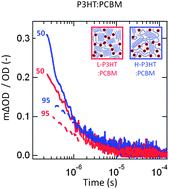The “working horse” of current organic photovoltaics research are the polymers P3HT and PC(61)BM. Both materials have been characterized extensively in single layers as well as in devices. To date, a wide range of power conversion efficiency values have been reported and linked to various factors including material sources and processing conditions.

A distinct increase in dissociated excitons was found for the high weight P3HT even under different concentration levels for both devices.
To distinguish between different mechanisms of phase formation in both types, pristine layers of each molecule type were deposited and laminated. Upon short heating (30s, 150°C), similar phase intermixing and subsequent reduction of crystallinity was observed for both types.
The L-P3HT is assumed to aggregate easier as the average chain length is smaller. Upon heating, separation of both materials is induced which in turn leads to a loss of the finely intermixed phase. The H-P3HT is assumed to incorporate less mobile amounts of PCBM due to the macromolecular structure of the folded molecules. Thus the H-P3HT type yields higher exciton dissociation rates and thus possibly larger efficiencies.
By Sebastian Axmann
Read the article in EES:
On the role of intermixed phases in organic photovoltaic blends
Paul Westacott, John R. Tumbleston, Safa Shoaee, Sarah Fearn, James H. Bannock, James B. Gilchrist, Sandrine Heutz, John deMello, Martin Heeney, Harald Ade, James Durrant, David S. McPhail and Natalie Stingelin
DOI: 10.1039/C3EE41821A










